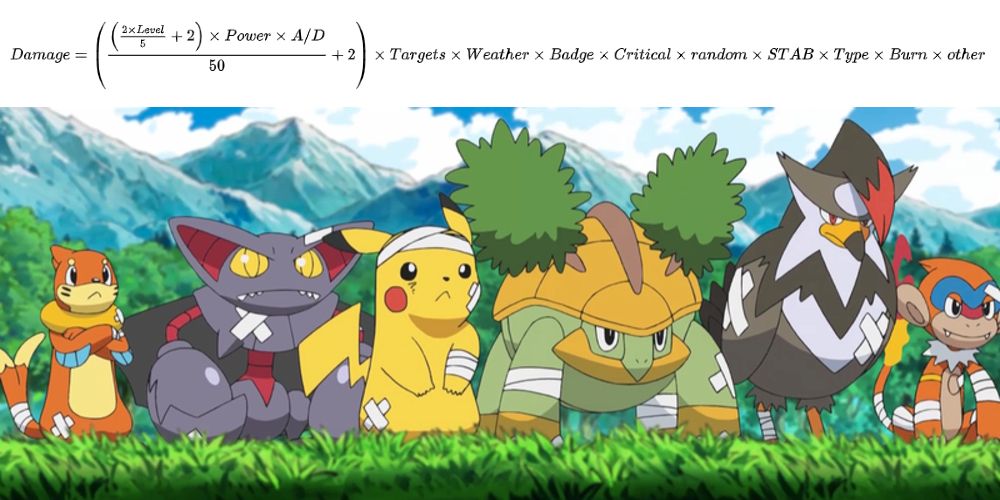Quick Links
How much damage one's moves do in the main series Pokemon games, such as in Pokemon Sword & Shield, is not based solely on the strengths of the combatants. There are many factors that are fed into a predetermined mathematical equation every time that an attack is launched and hits its mark.
RELATED: Pokemon Sword & Shield: How To Evolve Charjabug
The most dominant factors of damage calculation are the ones most trainers are familiar with: the base power of a move, the Attack or Special Attack stat of the attacker, as well as the Defense or Special Defense of the defender. But much more governs how damaging a launched move will be when it lands, so it may be best to think of damage in games like Pokemon Sword & Shield more like water as if it is passing through many filters that can decrease or increase its pressure.
The Damage Calculation Equation

For those who don't often delve into complex mathematical formulas for fun, this string of factors may be less decipherable than ancient Egyptian hieroglyphics when taken in as a whole. However, when broken down, any player can wrap their heads around this equation.
As is consistent in mathematics, the factors inside the brackets, starting with the innermost bracketed information, shall be explained first (with the exception of what Damage means). Every word and letter in the equation will be explained below, which should allow trainers to understand the different factors as well as should grant them the proper insight to apply this equation to specific scenarios of interest.
Damage Calculation Equation Breakdown
- Damage the number of individual Hit Points (HP) that the target will lose after all calculations are made
- Level is the level number of the attacking pokemon
- Power is the base power of a move
- A is the Attack or Special Attack stat of the attacking pokemon (determined by if the attacking pokemon uses a physical or special move)
- D is the Defense or Special Defense of the defending pokemon (also determined by if the attacking pokemon uses a physical or special move)
- Targets represents a move's effectiveness when used against foes, and will be 1 against a singular enemy, 0.75 if the attacker is using their move against more than one opponent, or will be 0.5 in Battle Royales
- Weather is the damage multiplier that is 1 by default but will become 1.5 if the attacker is using a Water-type move while Rain is active or if they use a Fire-type move when Sunny Day is active, and, additionally, can become 0.5 if the attacker uses a Water-type move while Sunny Day is active or if they use a Fire-type move while Rain is active
- Badge is an archaic and obsolete factor remaining in the equation for unknown reasons and will simply be 1 in every Pokemon game except those of Generation II, where this factor would be 1.25 if the attacker uses a move of a type corresponding to that of all badges earned so far (for example, after getting the Zephr Badge, all Flying-type moves will make this factor 1.25)
- Critical will be 1 in most cases but is the multiplier applied when the attacker lands a move that turns out to be a Critical Hit, which will make this factor become 1.5
- random is a chaotic value between 0.85 and 1 that is determined by RNG (random number generator) and represents the natural variance that can occur in battle, which can only potentially decrease a move's overall damage and is considered by many hardcore gamers to be a prime example of "artificial difficulty" in the franchise
- STAB stands for Same Type Attack Bonus and will be 1 unless the attacker uses a move that matches their type, in which case this value will become 1.5 (or 2 if the attacker has the Adaptability ability)
- Type refers to the type effectiveness of a move as determined by the type of the attacker's move as well as the type of the defending pokemon, which result in this factor being one of the following: 0 if the defender is immune, 0.25 if the defender is x2 resistant, 0.5 if the defender is resistant, 1 if the defender is neutral, 2 if the defender is weak to the attacking type, or 4 if the defender is x2 weak to the attacking type
- Burn is normally 1 but will become 0.5 if the attacker has the Burned status condition and uses a physical move (this factor gets ignored and stays at 1 if the attacker is Burned but has the Guts ability or if they use Facade)
- other is 1 by default but represents miscellaneous factors that are determined by the effects of specific moves, abilities, or items

